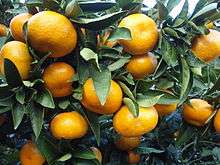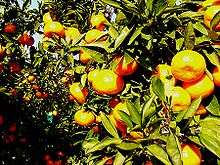Citrus unshiu
| Citrus unshiu | |
|---|---|
 | |
| Scientific classification | |
| Kingdom: | Plantae |
| (unranked): | Angiosperms |
| (unranked): | Eudicots |
| (unranked): | Rosids |
| Order: | Sapindales |
| Family: | Rutaceae |
| Genus: | Citrus |
| Species: | C. unshiu |
| Binomial name | |
| Citrus unshiu (Yu.Tanaka ex Swingle) [[.]] | |
Citrus unshiu is a seedless and easy-peeling citrus species, also known as unshu mikan,[1] cold hardy mandarin,[2] satsuma mandarin,[2] satsuma orange, naartjie,[2] and tangerine.[2] It is of Chinese origin, named after Unsyu (Wenzhou), China, but introduced to the West via Japan.[1][3][4][5]
Nomenclature
The unshiu is known as wēnzhōu mìgān (simplified Chinese: 温州蜜柑; traditional Chinese: 溫州蜜柑) in China, and mikan in Japan (or formally unshū mikan (温州蜜柑), the Japanese reading of the characters used in Chinese). In both languages, the name means "honey citrus of Wenzhou" (a city in Zhejiang province, China). An alternative Chinese name, (Chinese: 无核桔; pinyin: wúhé jú), means "seedless mandarin".
One of the English names for the fruit, satsuma, is derived from the former Satsuma Province in Japan, from which these fruits were first exported to the West.
The Afrikaans name naartjie is also used in South African English. It came originally from the Tamil word nartei, meaning citrus.[6]
Classification
Under the Tanaka classification system, Citrus unshiu is considered a separate species from the mandarin. Under the Swingle system, unshius are considered to be a group of mandarin varieties.[7] Genetic analysis has shown the Satsuma to be a highly-inbred mandarin-pomelo hybrid, with 22% of its genome, a larger proportion than seen in most mandarins, coming from pomelo. It arose when a mandarin of the low-pomelo huanglingmiao/kishu variety (placed in C. reticulata by Tanaka) was crossed with a pomelo or pomelo hybrid, then the resulting cultivar was backcrossed with another huanglingmiao/kishu mandarin.[8][9]
Characteristics

Its fruit is "one of the sweetest citrus varieties, with a meltingly tender texture"[10] and usually seedless, about the size of other mandarin oranges (Citrus reticulata). One of the distinguishing features of the satsuma is the thin, leathery skin dotted with large and prominent oil glands, which is lightly attached around the fruit, enabling it to be peeled very easily in comparison to other citrus fruits. The satsuma also has particularly delicate flesh, which cannot withstand the effects of careless handling. The loose skin of the satsuma means that bruising and damage to the fruit may not be immediately apparent upon the typical cursory visual inspection associated with assessing the quality of other fruits. In this regard, the satsuma might be categorised as a hit-and-miss citrus fruit; the loose skin particular to the fruit precluding the definitive measurement of its quality by sight and feel alone.
Satsumas grown in humid areas may be ripe while the skin is still green.[11]
Satsumas are cold-hardy, and when planted in colder locations, the fruit becomes sweeter from the colder temperatures. A mature satsuma tree can survive down to −9 °C (15 °F) or even −11 °C (12 °F) for a few hours.[12] Of the edible citrus varieties, only the kumquat is more cold-hardy. Satsumas rarely have any thorns, an attribute that also makes them popular. They can be grown from seed, which takes about 8 years until the first fruits are produced, or grafted onto other citrus rootstocks, such as trifoliate orange.
History
Jesuits brought the fruit from Asia to North America in the 18th century, starting groves in the Jesuit Plantation upriver from New Orleans, Louisiana (then a part of New Spain). The municipal street "Orange" in New Orleans, was originally named "Rue Des Orangers" and the site of the Jesuit grove. The groves were later re-cultivated farther south in Plaquemines Parish to provide greater protection from harmful frosts, and have continued to the present day. The Becnel family are the largest growers of Louisiana Citrus.[13]
The fruit became much more common in the United States starting in the late 19th century. In 1878 during the Meiji period, Owari mikans were brought to the United States from the Satsuma Province in Kyūshū, Japan, by the spouse of the US Minister to Japan, General Van Valkenberg, who renamed them satsumas.[14] Between 1908 and 1911 about a million Owari mikan trees were imported throughout the lower Gulf Coast states.[12] Owari is still commonly grown in Florida.[11] The towns of Satsuma, Alabama; Satsuma, Florida; Satsuma, Texas; and Satsuma, Louisiana were named after this fruit. By 1920 Jackson County in the Florida Panhandle had billed itself as the "Satsuma Capital of the World." However, the commercial industry was damaged by a −13.3 °C (8.1 °F) cold snap in 1911, a hurricane in 1915,[12] and a very cold period in the late 1930s.
Distribution
Citrus unshiu is grown in Japan, Spain, central China, Korea, the US, South Africa, South America, New Zealand, and around the Black Sea.[11][14]
Varieties
Unshiu varieties cluster among the mandarin family.[15] There are, however, some hybrids.
Possible non-hybrids
- Kishu mikan
- Onshu mikan
- Ōgonkan or Ki-mikan
- Komikan
Hybrids
References
- 1 2 Schlegel, Rolf (2009). Dictionary of Plant Breeding (2nd ed.). CRC Press. p. 437. ISBN 9781439802434.
It's named after, Unsyu, China; in Japan it is known as "unshu mikan," in China, as "wenzhou migan"; recorded cultivation of the "wenzhou migan" date back some 2,400 years; it was listed as a tribute item for Imperial consumption in the TANG Dynasty; the best record of the cultivation of this variety in ancient China is from Jijia Julu, written by Han YAN, the governor of the region and published in 1178
- 1 2 3 4 Michel H. Porcher (ed.). "Sorting Citrus names". Multilingual Multiscript Plant Name Database. The University of Melbourne.
- ↑ "Japanese Mikan and Satsuma Oranges". hawaii.edu.
Mikan is a tangerine-like citrus fruit that is grown in warmer regions of Japan in large quantities. Many different varieties have been introduced to Japan from China since the eighth century, but since the late 19th century the most important variety has been the unshu.
- ↑ "Citrus unshiu". Germplasm Resources Information Network (GRIN). Agricultural Research Service (ARS), United States Department of Agriculture (USDA). Retrieved 11 December 2017. "probable origin in Kyushu islands, Japan or imported from China to Japan."
- ↑ Misaki, Akira (November 1999). "紀州有田みかんの起源と発達史" [The Origin and the Development-Process of "Kisyu Arida Mikan (Arida Mandarin)"]. 経済理論 [The Wakayama Economic Review] (in Japanese). University of Wakayama. 292: 97–118. Archived from the original on 2001-01-10.
(After the many years of research, Dr. Tanaka has concluded the place of origin of Satsuma is Nagashima, Kagoshima. Satsuma is a chance seedling of Sōkitsu, Mankitsu, or Tendaisankitsu introduced from Huangyan Zhejiang, China. It appeared in the early Edo period.)
- ↑ Branford, Jean (1978). A dictionary of South African English. Oxford University Press.
- ↑ "New universal mitochondrial PCR markers reveal new information on maternal citrus phylogeny". Tree Genetics & Genomes. 7: 49–61. doi:10.1007/s11295-010-0314-x.
- ↑ Wu, Guohong Albert; Terol, Javier; Ibanez, Victoria; López-García, Antonio; Pérez-Román, Estela; Borredá, Carles; Domingo, Concha; Tadeo, Francisco R; Carbonell-Caballero, Jose; Alonso, Roberto; Curk, Franck; Du, Dongliang; Ollitrault, Patrick; Roose, Mikeal L. Roose; Dopazo, Joaquin; Gmitter Jr, Frederick G.; Rokhsar, Daniel; Talon, Manuel (2018). "Genomics of the origin and evolution of Citrus". Nature. 554: 311–316. doi:10.1038/nature25447. and Supplement
- ↑ Shimizu, Tokurou; Kitajima, Akira; Nonaka, Keisuke; Yoshioka, Terutaka; Ohta, Satoshi; Goto, Shingo; Toyoda, Atsushi; Fujiyama, Asao; Mochizuki, Takako; Nagasaki, Hideki; Kaminuma, Eli; Nakamura, Yasukazu (30 November 2016). "Hybrid Origins of Citrus Varieties Inferred from DNA Marker Analysis of Nuclear and Organelle Genomes". PLoS One. 11. doi:10.1371/journal.pone.0166969. e0166969.
- ↑ Elisa Bosley. "In Season: Satsuma Oranges". CookingLight. Retrieved 2015-02-25.
- 1 2 3 P. C. Andersen; J. J. Ferguson; T. M. Spann. "HS195/CH116: The Satsuma Mandarin". ufl.edu.
- 1 2 3 ""Orange Frost", a new cold hardy citrus". PLANTanswers.
- ↑ WWNO (2009-10-03). "Satsumas". Publicbroadcasting.net. Archived from the original on 2012-01-17. Retrieved 2009-12-06.
- 1 2 Saunt, James (2000). Citrus varieties of the world : an illustrated guide (2nd ed.). Norwich, England: Sinclair International Ltd. ISBN 1872960014. OCLC 45130256.
- ↑ Barkley, NA; Roose, ML; Krueger, RR; Federici, CT. "Assessing genetic diversity and population structure in a citrus germplasm collection utilizing simple sequence repeat markers (SSRs)". doi.org. 112: 1519–1531. doi:10.1007/s00122-006-0255-9. PMID 16699791.
- ↑ "Kinkoji unshiu mandarin (graft) hybrid Citrus neo-aurantium". Citrus Variety Collection. University of California Riverside.
- ↑ Kuniaki Sugawara; Atsushi Oowada; Takaya Moriguchi1; Mitsuo Omura (1995). "Identification of Citrus Chimeras by RAPD Markers" (PDF). Hort Science. 30 (6): 1276–1278.
External links
| Wikimedia Commons has media related to Citrus unshiu. |